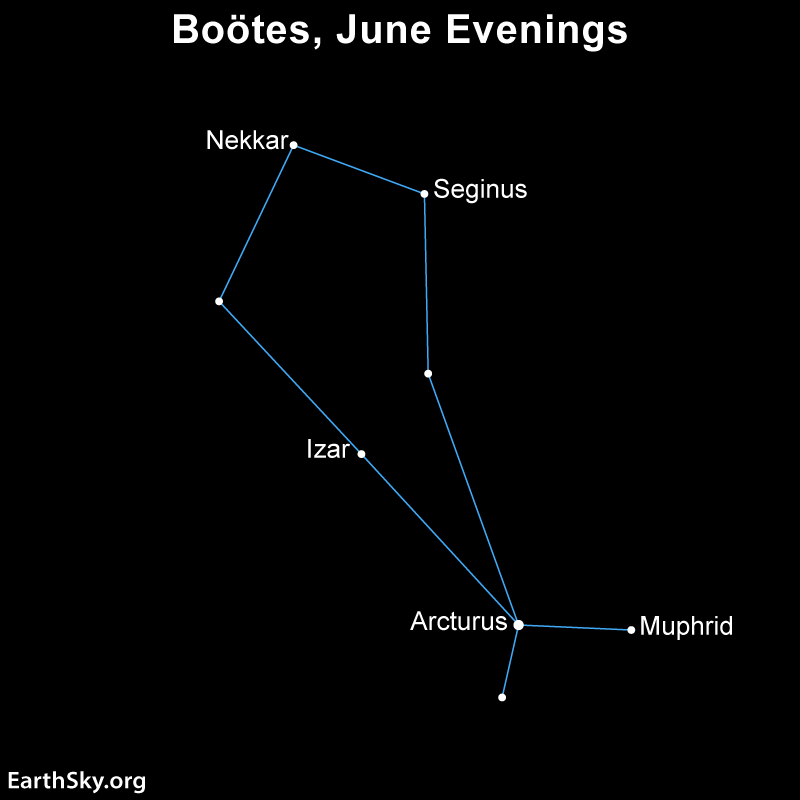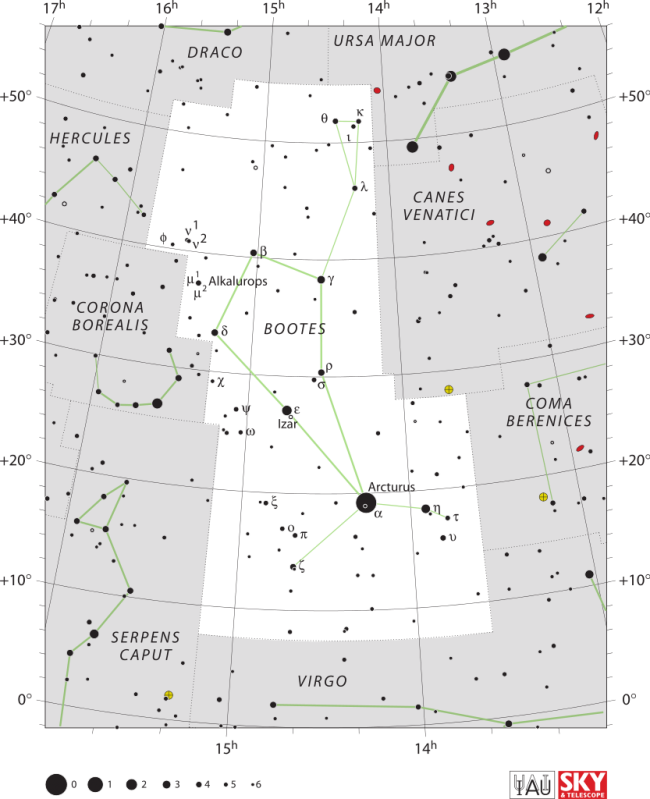
Boötes the Herdsman is a Northern Hemisphere constellation best seen in the late spring or early summer. It’s one of the largest constellations in the sky, ranking 13th out of 88. Boötes is most famous for its bright star Arcturus, which is the fourth brightest star in the night sky.
Locating the constellation Boötes
You can find Boötes south of Ursa Major the Great Bear, off the handle of the Big Dipper. Boötes’s brightest star, Arcturus, is part of a mnemonic device used to orient people to the night sky. Because the Big Dipper is easy for most observers to find, the handle of the dipper is used to point to other important stars. The saying goes, “Arc to Arcturus, speed on down to Spica.” This means that as you follow the curve in the dipper’s handle away from Ursa Major, you will run into a bright star, and this is Arcturus in Boötes. The other star mentioned in the saying is Spica, which is a part of Virgo.

Tracing out the shape of Boötes
Boötes is supposed to be the figure of a man, which is somewhat recognizable with its tall diamond shape and two stick legs jutting out at the bottom. The point at which the tall diamond shape and stick legs intersect is the star Arcturus. The Herdsman also appears to have his left arm raised over his head.
The stars in the Herdsman
Arcturus, the brightest star in Boötes, shines at magnitude -0.05. Arcturus is the fourth brightest star in the night sky. The name Arcturus means bear watcher or bear guard, referring to its closeness to Ursa Major. Lying 37 light-years away, Arcturus (or Alpha Boötis) glows with a faint orange hue.
The second brightest star in Boötes lies on the left side of the diamond shape. Ten degrees up from Arcturus is where you will find Izar, or Epsilon Boötis, a magnitude 2.35 star lying much farther away, at 210 light-years.
The third brightest star in Boötes is his left knee, which is found to the lower right of Arcturus (assume that all objects in the sky are facing you, the observer). This star is Muphrid, or Eta Boötis, at magnitude 2.68. Muprhid lies 37 light-years away.

Fainter stars in Boötes
The other stars in the body of the Herdsman are all of comparable brightness. Starting above Izar and working up, around and back toward Arcturus are the stars Delta Boötis, Beta Boötis (or Nekkar – and consider this Boötes’ neck), Gamma Boötis (or Seginus) and Rho Boötis.
Delta Boötis shines at magnitude 3.46 at a distance of 121 light-years. Nekkar shines at magnitude 3.49 and lies 219 light-years distant. Seginus has the brightest magnitude of these four stars, at 3.04. It is also the closest of the four at 84 light-years. Finally, Rho Boötis, which lies almost even with Izar, shines at magnitude 3.57 and lies 149 light-years away.
Arcturus shows large proper motion
The bright orange star Arcturus is especially noteworthy for its large proper motion, or sideways motion as seen on the dome of Earth’s sky. Arcturus is actually moving at a tremendous speed (122 km/s or 76 miles/s) relative to our solar system. From the vantage point of Earth, Arcturus is rapidly moving in a southerly direction at a rate of 3.9 arcminutes per century. It’s closest point to Earth is about 4,000 years from now. As it moves away it will vanish from visibility to the unaided eye when it reaches the Carina-Vela border in about 150,000 years.
Constellation Boötes proper motion from 30k years ago to 30k years from now. pic.twitter.com/tXHd7cFdFc
— Tony Dunn (@tony873004) June 16, 2022
Why is Arcturus so much brighter and why does it move so much faster than the other stars in the constellation? The answer is because Arcturus is much closer to us compared to the other stars in Boötes.
Bottom line: Boötes the Herdsman is a large constellation that holds one of the brighter stars in the sky, Arcturus.
The post Boötes the Herdsman and its bright star Arcturus first appeared on EarthSky.
0 Commentaires